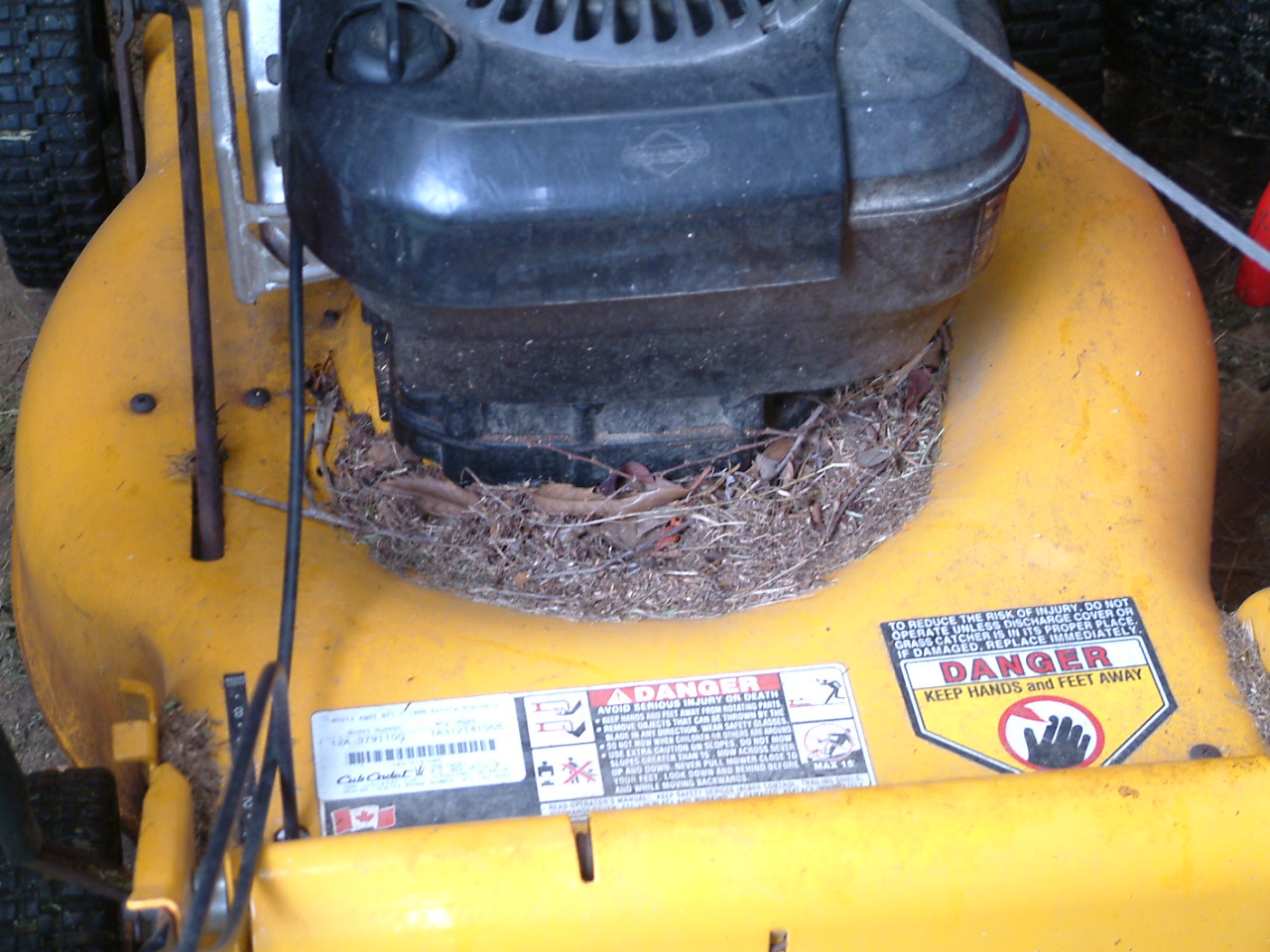
by Beth Bolles | Sep 18, 2018
Just when you think your battle against weeds is over for the summer, cooler nighttime temperatures and shorter days spark the beginning of a new crop of your least favorite plants. The question of many homeowners is how did all the weeds get to my landscape?
There are many ways that weeds make it to the landscape. They can be brought in with new soil, mulch, container plants, dropped by birds, delivered on the fur of animals, carried by wind, or on the deck of a lawn mower. If that is not enough to depress you than also realize that regardless of outside sources of weeds, your landscape already has plenty onsite that you don’t even know about.
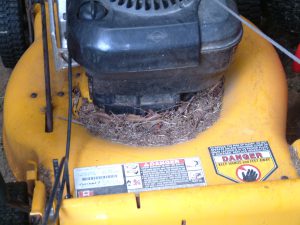
The deck of a lawn mower can collect plant debris, including seeds, that are spread through the landscape. Photo by Beth Bolles, UF IFAS Extension Escambia County.
In the soil, there is a large number of weed seeds ready to germinate when the conditions are just right. Understanding how your common landscape practices can encourage or discourage the germination of these seeds, can help you begin to manage some weed infestations.
Many of the seeds of common annual weeds are very small. They require exposure to sunlight in addition to the proper temperatures and moisture to germinate. Sunlight is critical though and seeds will not germinate without adequate sunlight. If the small seeds are deep in the soil, you will probably never know they are there. When you turn soil or disturb soil such as when installing plants, you bring the small seeds close to the surface and closer to light. They can then be stimulated to germinate. The next thing you know is that you have an area covered in weed seedlings.
What does this mean for your gardening practices? Try your best to block sunlight from hitting exposed soil. You can do this by keeping a healthy turf, free of thinning spaces. A 2-3 inch layer of mulch in plant beds and vegetable gardens will reduce weed seed germination. Finally when you are installing plants in an established bed, try not to mix soil with surrounding mulch. Seeds will easily germinate within the mulch if it becomes mixed with soil.
It is inevitable that your landscape will have some weeds but a few easy gardening practices can reduce some of your weed frustrations.
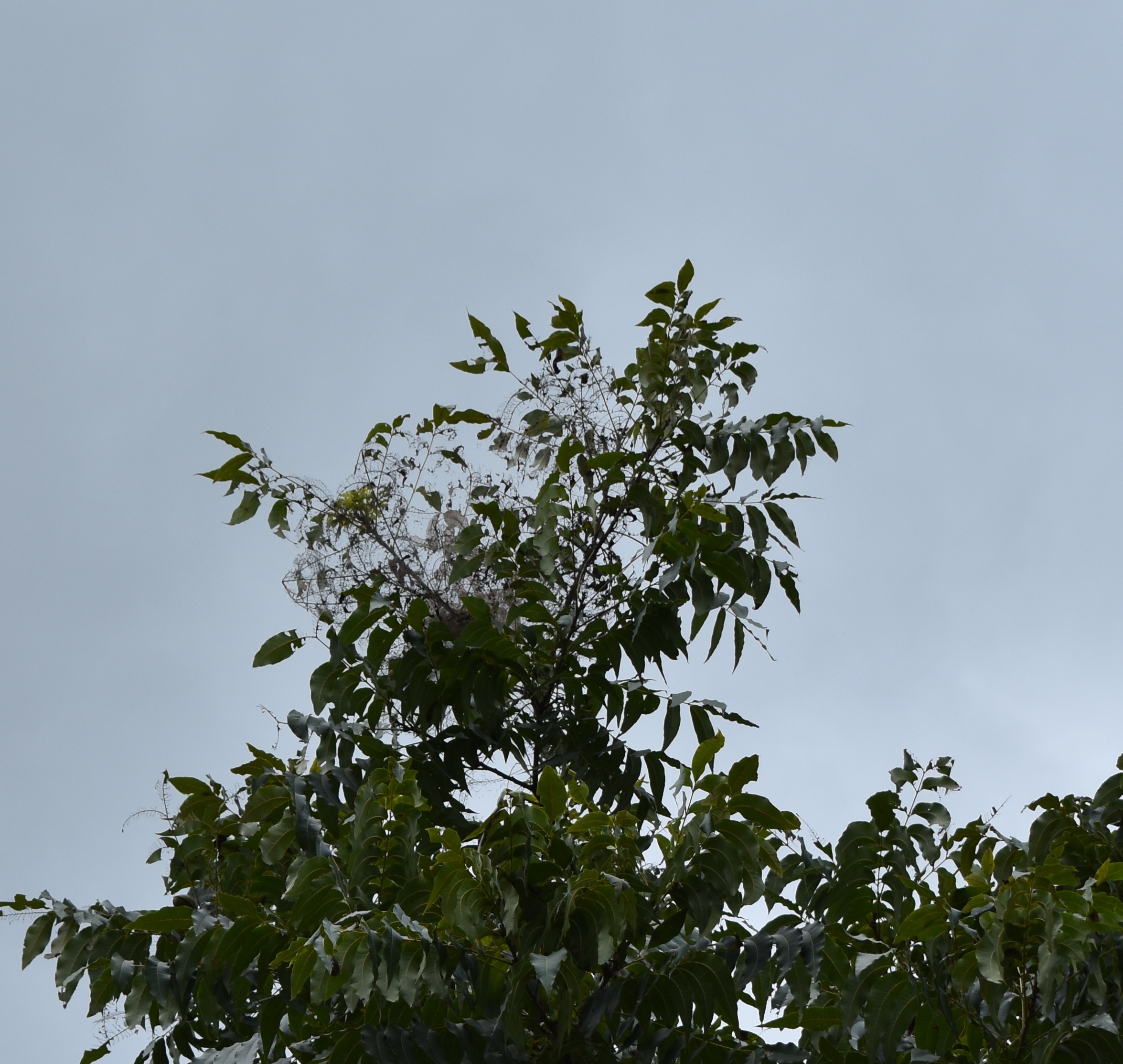
by Matthew Orwat | Sep 13, 2018
Bare limb tips and clusters of webbing in pecan trees are often the first sign that fall is right around the corner.
This webbing is caused by clusters of the larvae of the Fall Webworm (Hyphantria cunea (Drury)) which is often also called Pecan Webworm. “Fall Webworm” is a bit of a misnomer in our region since they are able to strike in spring and summer thanks to our long growing season. They are most noticeable in the fall thanks to cumulative effects of earlier feeding.
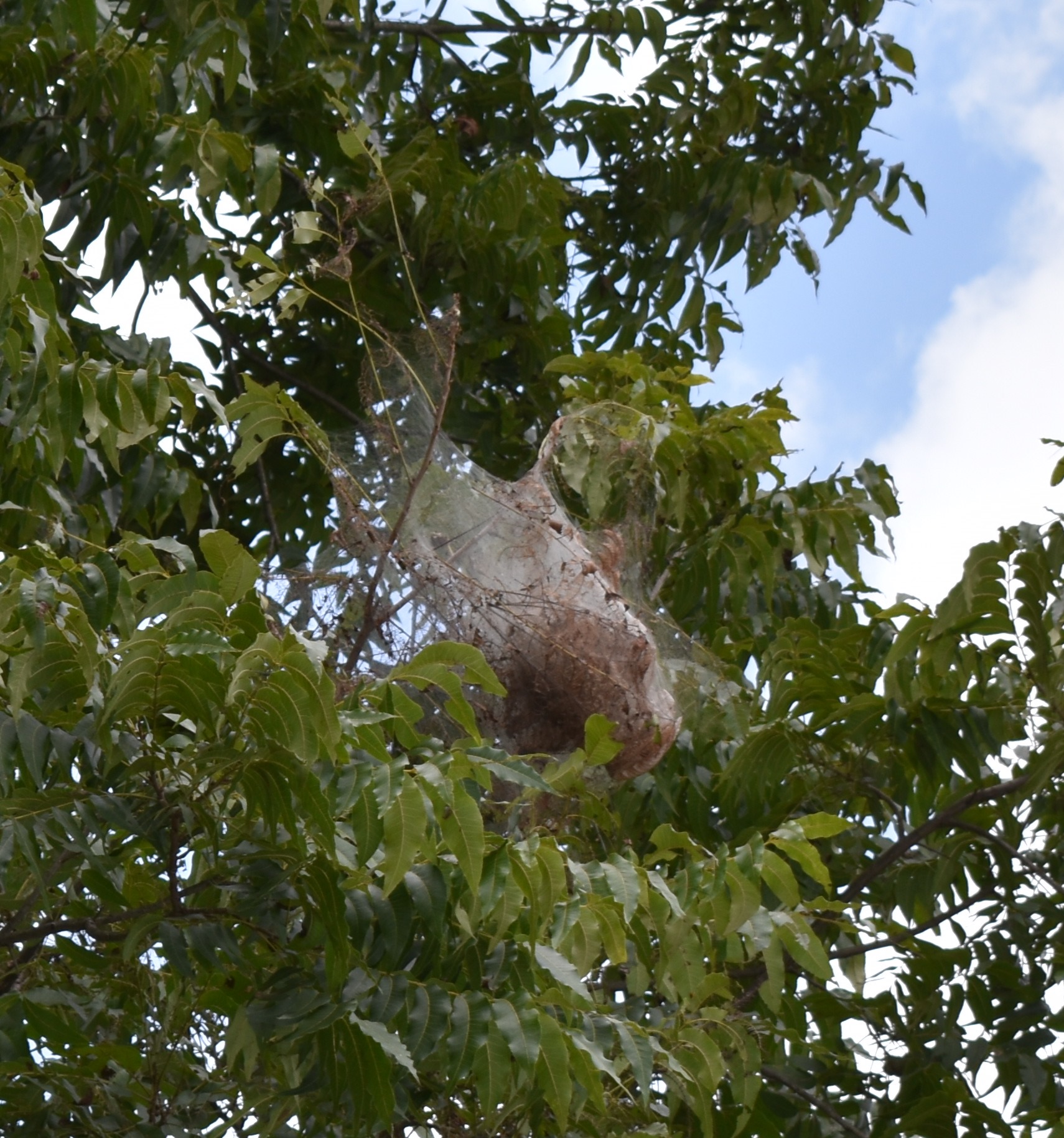
The adult form of the fall webworm is a solid white or white and brown spotted moth that emerges in late March through August in southern climates. After mating they lay orderly clusters of green eggs, usually May through August. Soon after emergence, the larvae begin creating silk webs to protect themselves as they voraciously feed on their various host plants, of which Pecan is most common in Northwest Florida gardens.
Although they are capable of defoliating complete trees, especially smaller ones, most seasons they are kept in check by beneficial insects such as the paper wasp. It is beneficial for small orchards or home growers to scout their trees from June through August. If small webs are observed in young trees, it is best to prune them out with a pole saw or pole pruner and dispose of the branch. Pruning of small branches does not harm the tree, but it may be of no benefit to remove small webs in larger trees, if they are being controlled by natural enemies.
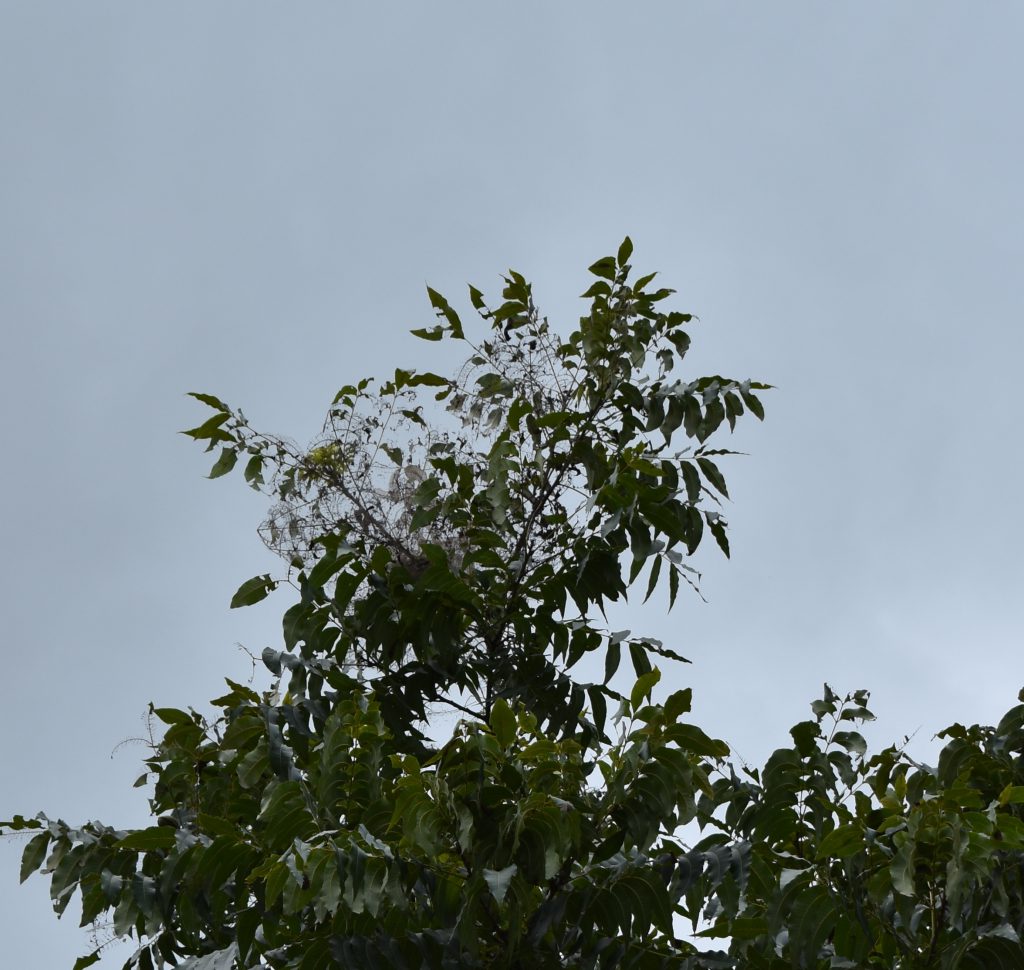 Most home gardens don’t have a practical ability to spray for this insect. For homeowners it is difficult to spray for control, due to the cost of the equipment required to get the spray into the tree canopy. If spraying is an option, many insecticides containing spinosad or Bacillus thuringiensis (Bt) exist. Both of these products target caterpillars while not harming beneficial insect predators that feed on these worm populations. Several more toxic insecticide products exist that will control fall webworm, but they often exacerbate insect problems by killing off beneficial insects that might be controlling other insect pests.
Most home gardens don’t have a practical ability to spray for this insect. For homeowners it is difficult to spray for control, due to the cost of the equipment required to get the spray into the tree canopy. If spraying is an option, many insecticides containing spinosad or Bacillus thuringiensis (Bt) exist. Both of these products target caterpillars while not harming beneficial insect predators that feed on these worm populations. Several more toxic insecticide products exist that will control fall webworm, but they often exacerbate insect problems by killing off beneficial insects that might be controlling other insect pests.
Fall webworm is not usually a serious problem for home gardens. Let natural enemies take care of the problem in most cases.
Supplemental Material:

by Ray Bodrey | Sep 6, 2018
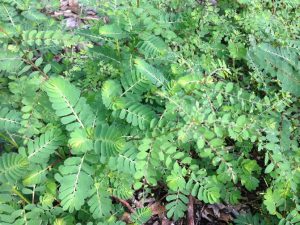
Figure 1: Chamberbitter, a common annual weed.
Credit: Mary Salinas, UF/IFAS Extension Santa Rosa County.
With daily rainfall occurring regularly, coupled with humid temperatures, summer annual weeds have had a mighty boost in growth. Chamberbitter, Florida pusley, sedge and oxalis are just some examples of the many weeds that are exploding across our landscape.
Chamberbitter (Phyllanthus urinaria) is found as north as Illinois and as west as Texas, but thrives in lower southeastern states. It’s a headache for homeowners as well as pasture managers. The foliage resembles that of the mimosa tree (Albizia julibrissin) and can be confused with the native mimosa groundcover, known as powderpuff mimosa (Mimosa strigillosa). This plant grows upright and develops a long taproot. Wart-like seeds can be found on the underside of the branch.
Florida Pusley (Richardia scabra L.) also known as Florida snow or Mexican clover, has recently blanketed landscapes in the Panhandle with white flowers. It’s a persistent weed that moves quickly.
Sedges and sedge-like plants (Cyperus ssp.), known as kyllinga, are species that emerge in late spring and thrive in summer months in warm, moist climates. Excessive irrigation or areas with poor drainage create a very hospitable environment for these weeds. Sedges are annual grass-like plants have an elaborate flower-bearing stems. Yellow and purple nutsedge are the most common species. Kyllingas have smaller leaves and are less vertical. Sedges and kyllingas are fast spreading, and reproduce through seed and rhizomes, or underground tubers.
Oxalis or yellow woodsorrel (Oxalis stricta) have heart-shaped lobes and have a bright yellow flower. Oxalis reproduces by seed and have a narrow “okra-like” seed pod.

Figure 1: (L to R) Chamberbitter, Pusley, Sedge, Kyllinga & Oxalis.
Credit: Stephen H. Brown, UF/IFAS Extension Lee County
What about control? Some cultural control methods are hand removal and mowing frequently to offset the life cycle, but these practices alone will most likely not solve the problem. There are many broad spectrum herbicides that can be used to control these weeds with good results, but you must be persistent. Some are season long applied products. However, most effective products need to be applied in cooler temps than we have now. Consecutive days of temperatures of less than 90 degrees would be optimal. Applying the chemical otherwise will most likely harm the turfgrass. Be aware, some productions will injure or kill centipede and St. Augustine, but are safe to use on other turfgrasses like bermuda, bahia and zoysia. Be sure to read the label and follow the directions and precautions.
Another option is non-selective herbicides, like glyphosate, which can be used in thick patches or for spot treatment. When using a selective herbicide, remember to protect turfgrass and other plants from spray drift or any contact, especially regarding ornamental plants and trees.
Contact your local county extension office for more information.
Supporting information for this article is from the following online publications:
Clemson Cooperative Extension publication: “Chamberbitter”, Bulletin HCIC 2314: http://www.clemson.edu/extension/hgic/pests/pdf/hgic2314.pdf
UT Institute of Agriculture document, “Nutsedge and Kyllinga Species” by Mathew T. Elmore, James T. Brosnan and Gregory K. Breeden: http://www.tennesseeturfgrassweeds.org/Lists/Fact%20Sheets/Attachments/23/W260updated2015.pdf
UF/IFAS EDIS publications: “Yellow Woodsorrel (Oxalis) Biology and Management in Turf” by J. Bryan Unruh, Ramon G. Leon, and Darcy E. P. Telenko: http://edis.ifas.ufl.edu/pdffiles/EP/EP38500.pdf
“Weed Management Guide for Florida Lawns” by J. Bryan Unruh, Ramon G. Leon, Barry J. Brecke, and Laurie E. Trenholm: http://edis.ifas.ufl.edu/pdffiles/EP/EP14100.pdf
UF/IFAS Extension is an Equal Opportunity Institution.
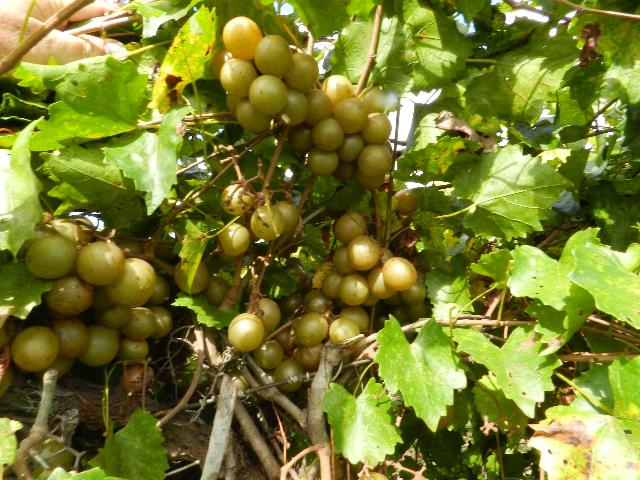
by Mark Tancig | Sep 6, 2018
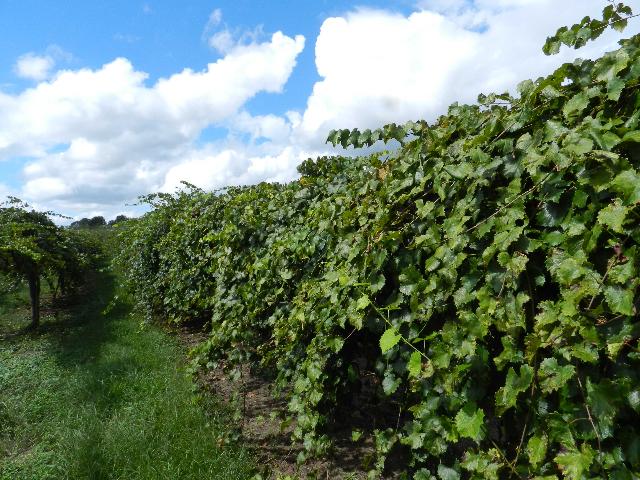
A grape vineyard. Credit: Peter Andersen, UF/IFAS.
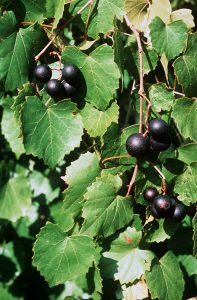
The classic muscadine (Vitis rotundifolia). Credit: Carl Hunter. USDA-PLANTS Database.
This is the time of year to be on the watch for purple-stained sidewalks and driveways – a sign that ripe muscadine grapes are falling from above. The muscadine grape (Vitis rotundifolia) is a native Florida vine that has been enjoyed by Native Americans, colonists, and contemporary Floridians alike. In addition to the classic muscadine and scuppernong, a light-colored variety of muscadine, there are five other native species of grape (Vitis spp.) to be found growing in natural areas or along woodland edges. All are edible, however, the muscadine has the largest, tastiest fruit.
Many north Florida gardeners have some species of grape growing in their landscapes and consider it a weed due to its aggressive growth. Unfortunately, since the vines are functionally dioecious (separate male and female plants) and most wild plants are male, it is unlikely that those annoying grapevines at the garden’s edge will ever bear fruit. But every now and again, luck strikes! That’s why finding a purple-stained sidewalk or parking area is such an exciting event. I have some of these locations saved in my memory to visit this time of year, especially since all the grapevines in my own property have yet to bear one fruit! If necessary, control methods for grapevine in a landscape include repeated pruning back or the use of herbicides. Muscadines and other grapes are intolerant of shade so will eventually perish if cut back and located under a canopy of trees or shrubs.
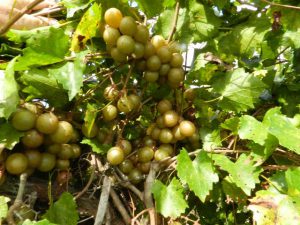
The bronze-colored scuppernong. Credit: Peter Andersen. UF/IFAS.
Good News! There are plenty of varieties bred for the backyard and commercial fruit grower. Since muscadines are native, they require little, if any, pesticides, making them a great choice for a sustainable landscape or orchard. The vines can be grown up an arbor or a complete vineyard trellis system can be built for maximum harvest. A UF/IFAS fact sheet called “The Muscadine Grape” (publication #HS763) contains all the information needed to choose the right variety, design a vineyard, and implement the best pruning, irrigation, and fertilization schedule.
Whether fresh off the vine or in jams or wine, muscadines are a sweet, summery treat for Floridians.
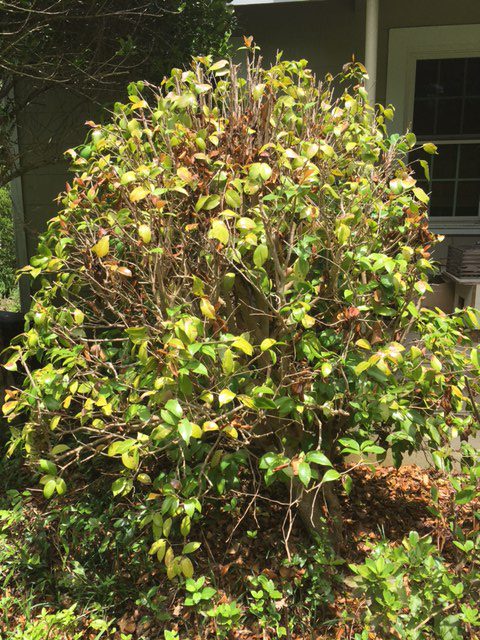
by Matt Lollar | Sep 6, 2018
A few months ago I visited a property that had been renovated to clean up some limbs that were in danger of falling on the house. Pruning tree limbs that are in danger of hitting a structure is always a good idea, but it’s important to look at the impacts this practice may have on the rest of a landscape. Any time the light profile of a landscape is changed, current and future plant selection must be considered. One often seen example occurs when trees grow to full size and shade out the lush lawn that’s underneath. However, in this case, removal of limbs allowed more light to shine on some beautiful, old camellia bushes.
Camellia Planting and Care
Camellias do best in locations that receive filtered sunlight and are protected from the wind. They like acidic, well-drained soils. Trees and shrubs are generally planted 2″ to 3″ above the soil grade. (2″ to 3″ of root ball should be exposed above the soil grade when the tree/shrub is planted.) To help improve root oxygen exposure and help prevent a root rot situations, camellias can be planted slightly shallower than the previously stated recommendation. For more plant establishment guidelines, please visit: UF/IFAS Planting and Establishing Trees Guide
Scenario and Diagnosis
As mentioned above, the property in question was visited to diagnose sick camellia bushes. Upon further inspection of the property, asking about recent changes to the landscape, and inspecting the bushes, it was clear that the camellias were receiving too much sunlight. Sunlight damage was expressed by large brown sunscald spots on the yellowing leaves.
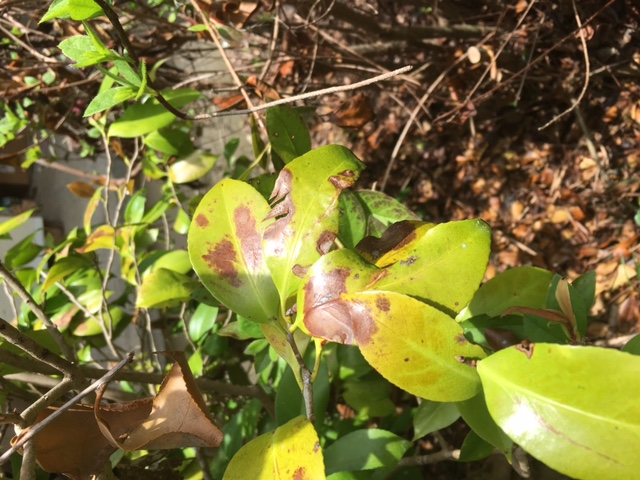
Sunscald damage on camellia leaves. Photo Credit: Jed Dillard
The camellias had also been pruned incorrectly. Camellias require minimal pruning. They are normally pruned to control size or promote a tree form structure if desired. Any pruning should be done before flower buds form in late summer.

An incorrectly pruned camellia bush. Photo Credit: Jed Dillard
Solution
The best solution in this scenario was to dig up the affected camellias and move them to a location with more shade. Sun loving shrubs were suggested as options to replace the camellia bushes. It’s important to note that Camellia sasanqua cultivars are usually more tolerant of sunlight than Camellia japonica cultivars. The recommendations were based on the Florida Friendly Landscaping principle of “Right Plant, Right Place”.
If you’re trying to find the right plants for you own yard, then you should check out the Florida Friendly Landscaping Interactive Plant Database. The database gives you plant selection options for each area of your yard based on location in the state, plant type, and soil and light conditions.













